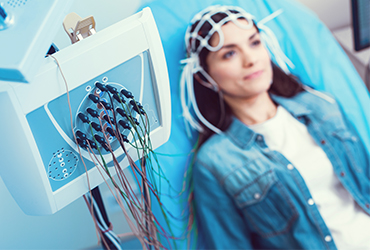Electroencephalography (EEG)
The test provides information about the function of brain. The test involves recording electrical activity generated by brain cells from the surface of brain. The tests provide useful information on diagnostic and prognostic information in certain conditions including seizure disorders, epilepsy, brain injuries, states of brain dysfunction and coma and other brain disorders.
Standard EEG
The test is carried out by qualified physiologists who attach wires with small metal disc electrodes at the ends to the scalp. The wires are then connected to hardware with an amplifier attached with a computer. No electric pulses are delivered and electrodes do not transmit any sensations. These just record your brain wave activity. The brain wave activity recorded shows up as wavy lines on an EEG recording. Once the electrodes and wires are attached, the recording is usually completed in 20 -60 minutes depending on requirements of the test. Physician neurophysiologist formulates and issues a report after analysing the results of the recording. The test is generally safe and painless and well tolerated. However, in order to increase the diagnostic yield of the test, certain exercises such as stimulation with strobe lights and breathing exercises are carried out in order to provoke epileptic changes in the recording. With these exercises, there remains a small risk of triggering a seizure during the test in patients with epilepsy, but appropriate medical supervision and care is provided if required.
Ambulatory EEG
Ambulatory EEG test is similar to a standard EEG test in recording electrical brain wave activity but allows recording for longer periods of up to several days, typically 48-72 hours. The recording continues when the patient is at home and is asleep. This test increases the chances of catching an epileptic seizure or epilepsy related activity.
Video-telemetry EEG
This test is carried out in a similar way to standard EEG test but involves admitting the patient in a hospital setting. The test allows continuous and prolonged recording of electrical brain wave activity and simultaneous video recording, over a period of several days, typically 3-5 days. This test is used in complex and difficult to diagnose patients with suspected epilepsy and in epilepsy patients who need workup before considering epilepsy surgery. This is also a better test in differentiating epileptic seizures from non-epileptic seizure like episodes.
